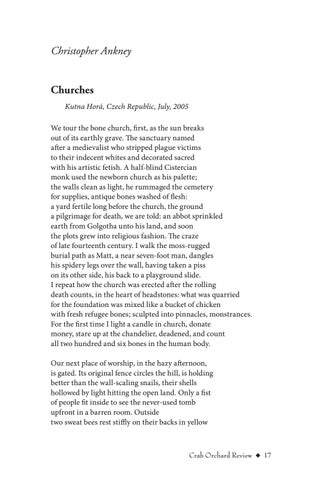Christopher Ankney Churches Kutna Horá, Czech Republic, July, 2005 We tour the bone church, first, as the sun breaks out of its earthly grave. The sanctuary named after a medievalist who stripped plague victims to their indecent whites and decorated sacred with his artistic fetish. A half-blind Cistercian monk used the newborn church as his palette; the walls clean as light, he rummaged the cemetery for supplies, antique bones washed of flesh: a yard fertile long before the church, the ground a pilgrimage for death, we are told: an abbot sprinkled earth from Golgotha unto his land, and soon the plots grew into religious fashion. The craze of late fourteenth century. I walk the moss-rugged burial path as Matt, a near seven-foot man, dangles his spidery legs over the wall, having taken a piss on its other side, his back to a playground slide. I repeat how the church was erected after the rolling death counts, in the heart of headstones: what was quarried for the foundation was mixed like a bucket of chicken with fresh refugee bones; sculpted into pinnacles, monstrances. For the first time I light a candle in church, donate money, stare up at the chandelier, deadened, and count all two hundred and six bones in the human body. Our next place of worship, in the hazy afternoon, is gated. Its original fence circles the hill, is holding better than the wall-scaling snails, their shells hollowed by light hitting the open land. Only a fist of people fit inside to see the never-used tomb upfront in a barren room. Outside two sweat bees rest stiffly on their backs in yellow
Crab Orchard Review
◆ 17
